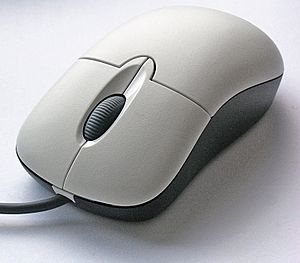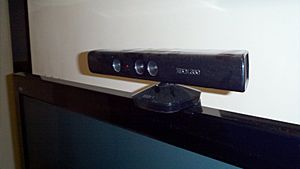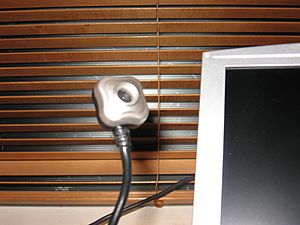Input device facts for kids
In computing, an input device is a piece of computer hardware equipment used to provide data and control signals to an information processing system such as a computer or information appliance. Examples of input devices include keyboards, mouse, scanners, digital cameras and joysticks.
Input devices can be categorized based on:
- modality of input (e.g. mechanical motion, audio, visual, etc.)
- whether the input is discrete (e.g. pressing of key) or continuous (e.g. a mouse's position, though digitized into a discrete quantity, is fast enough to be considered continuous)
- the number of degrees of freedom involved (e.g. two-dimensional traditional mice, or three-dimensional navigators designed for CAD applications)
Contents
Keyboard
'Keyboards' are a human interface device which is represented as a layout of buttons. Each button, or key, can be used to either input a character to a computer, or to call upon a particular function of the computer. They act as the main text entry interface for most users. Traditional keyboards use spring-based buttons, though newer variations employ virtual keys, or even projected keyboards.
Examples of types of keyboards include:
- Keyer
- Keyboard
- Lighted Program Function Keyboard (LPFK)
Mouse
Pointing devices are the most commonly used input devices today. A pointing device is any human interface device that allows a user to input spatial data to a computer. In the case of mouse and touchpads, this is usually achieved by detecting movement across a physical surface. Analog devices, such as 3D mice, joysticks, or pointing sticks, function by reporting their angle of deflection. Movements of the pointing device are echoed on the screen by movements of the pointer, creating a simple, intuitive way to navigate a computer's graphical user interface (GUI).
Examples of types of pointing devices include:
- mouse
- touchpad
- pointing stick
- touchscreen
- trackball
Composite devices

Input devices, such as buttons and joysticks, can be combined on a single physical device that could be thought of as a composite device. Many gaming devices have controllers like this. Technically mice are composite devices, as they both track movement and provide buttons for clicking, but composite devices are generally considered to have more than two different forms of input.
Examples of types of composite devices include:
- Joystick controller
- Gamepad (or joypad)
- Paddle (game controller)
- Jog dial/shuttle (or knob)
- Wii Remote
Video input devices
Video input devices are used to digitize images or video from the outside world into the computer. The information can be stored in a multitude of formats depending on the user's requirement.
Examples of types of video input devices include:
- Digital camera
- Digital camcorder
- Portable media player
- Webcam
- Microsoft Kinect Sensor
- Image scanner
- Fingerprint scanner
- Barcode reader
- 3D scanner
- Laser rangefinder
- Eye gaze tracker
Examples of medical video input devices include:
Audio input devices
Audio input devices are used to capture sound. In some cases, an audio output device can be used as an input device, in order to capture produced sound.Audio input devices allow a user to send audio signals to a computer for processing, recording, or carrying out commands. Devices such as microphones allow users to speak to the computer in order to record a voice message or navigate software.Aside from recording, audio input devices are also used with speech recognition software.
Examples of types of audio input devices include:
- Microphones
- MIDI keyboard or other digital musical instrument
Related pages
Images for kids
-
MEMS sensors (among other devices) used in a mobile device
-
Controllers for use with a virtual reality system
-
Microsoft Kinect sensor, works by detecting human motion visually
-
touchpad (or trackpad)
-
An infrared proximity sensor used in a smartphone allows it to turn off its screen when held up to the user's ear.
See also
 In Spanish: Periférico de entrada para niños
In Spanish: Periférico de entrada para niños






















